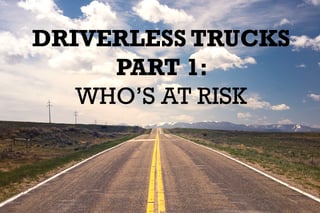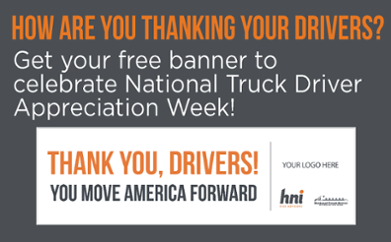 The future is upon us with the adoption of "driverless trucks" into the world of transportation. As with any innovation, there are always pluses and minuses, but first, we must assess what risks will soon flood our technology driven industry. Let's discuss what this major change means for you.
The future is upon us with the adoption of "driverless trucks" into the world of transportation. As with any innovation, there are always pluses and minuses, but first, we must assess what risks will soon flood our technology driven industry. Let's discuss what this major change means for you.
As a child, you may remember sitting in the backseat of your parents' car watching the various vehicles zoom past your child locked window to the world. Excitement would rush over you as you witnessed your favorite toy come to life, a massive truck. You'd see a smiling, friendly driver peer back at you and immediately "pump your arm" to signal to the driver, "honk your horn!" Those days are slowly disappearing into our rear view with driverless trucks on the horizon.
What are Driverless Trucks?
Driverless trucks are trucks that can be “driven” without a driver under certain circumstances, such as permitting weather conditions, through the use of GPS and laser radar technology. This new idea is similar to autopilot for an aircraft. Flip the switch and let the computers operate the vehicle!
So-called driverless trucks are becoming a reality at a quickening pace. As of late, the states of California, Florida, and Nevada have passed legislation allowing driverless trucks to be operated on a limited basis for demonstration and test purposes. The most notable state is Nevada where Daimler’s truck manufacturing unit, Freightliner, is conducting ongoing tests on selected stretches of highway. Famously coined the Inspiration Truck, it uses an advanced system, known as Highway Pilot, to test at speeds up to 50 miles per hour.
Presently, Driverless trucks on public roadways really aren’t “driverless”. A Driver is still in the truck, but can switch the driverless capability on or off, going hands and feet free on demand. Some refer to this as “autonomous mobility” which only works on limited stretches of open highway in clear weather. Over time, the idea is technology will enable more automated mobility (truly driverless) over more roadways in various weather conditions.
Driverless Trucks are Already a Reality
There are places where driverless trucks are already being utilized on non-public roadways WITHOUT drivers. Rio Tinto, a mining company in Australia, is operating 50 self-driving trucks. Additionally, The US Army uses driverless trucks manufactured by Lockheed-Martin in certain battle theaters and training bases to haul equipment and supplies. Suncor, an oil company in Alberta, Canada, has ordered 175 “autonomous ready” heavy haul trucks from manufacturer Komatsu, Ltd in anticipation of going driverless in the near future.
The stage is being set for the coming acts, where in the not too distant future there will be more trucks, logging more miles, on more public roadways without a driver. Freightliner’s plan is for the curtain to rise on the opening act by the year 2025.
While this innovation is sure to result in benefits and rewards, there are also certain risks that will be encountered. The emerging risks are already starting to be discussed in business and industry forums. Notably, in April at the 2015 annual Risk and Insurance Management Society (RIMS) conference (the largest world-wide gathering of risk management and insurance professionals), driverless vehicle risks were the subject of a panel discussion. Among the participants was the Director of Corporate Risk Management and Insurance for General Motors.
Examples of the risks that are being discussed:
RISK: Truck drivers losing their jobs (so-called “technological unemployment”). Less demand for truck drivers and related support employees and services. (Suncor projects 800 people will be “off-site” by the year 2020).
Who’s at Risk: Truck drivers and related support personnel. The Bureau of Labor Statistics states there are 1.6 million long haul drivers. According to the American Trucking Association, there are over 8 million trucking related jobs.
RISK: Trucking companies going out of business due to the resistence of adopting driverless technology and thus becoming less competive.
Who’s at Risk: Trucking company owners and investors.
RISK: Reduced demand for insurance due to fewer crashes.
Who’s at Risk: Insurance companies and insurance agents.
RISK: Reduced demand for truck repair services.
Who’s at Risk: Truck repair businesses. Fewer crashes means fewer trucks to repair.
RISK: Reduced demand for new trucks and trailers.
Who’s at Risk: Truck manufacturers and dealers. Fewer unrepairable trucks due to fewer severe crashes.
RISK: Truck stops will no longer be neccessary.
Who’s at Risk: Truck stop owners/operators and related suppliers. Driverless trucks have no need for the occasional pit stop.
RISK: Disruption of delivery consistency due to weather (technology only works in clear weather).
Who’s at Risk: Consumers.
RISK: Hacked guidance systems and software from malicious interference causing a breach of personal data.
Who’s at Risk: Cyber liability insurers and trucking companies.
RISK: No applicable case law precedents to use as basis for determining liability and evaluating merit of litigating crashes.
Who’s at Risk: Plaintiffs and Plaintiff attorneys. Should we sue? Will we prevail?
RISK: Ethics of man or machine being responsible for damage, injury, and death. Risk transfers from the trucker to the software provider and manufacturers. Who's at fault?
Who’s at Risk: Officers of technology and manufacturer suppliers to the auto industry. Society in general will have to decide who is liable.
RISK: Government regulators not passing legislation allowing driverless trucks to be used on public roadways.
Who’s At Risk: Investors in the enabling technology and equipment. Regulators themselves may be held responsible for crashes that could have been avoided had the vehicle been operating autonomously.
These examples illustrate the uncertainties that will come along for the driverless ride and there are likely to be more as this journey continues. As for Rewards, watch for my next blog, “Driverless Trucks Part 2: Who’s Rewarded?"
In the meantime, keep your eyes on the road ahead.
.png?width=69&height=53&name=Acrisure%20Logo%20(White%20Horizontal).png)


